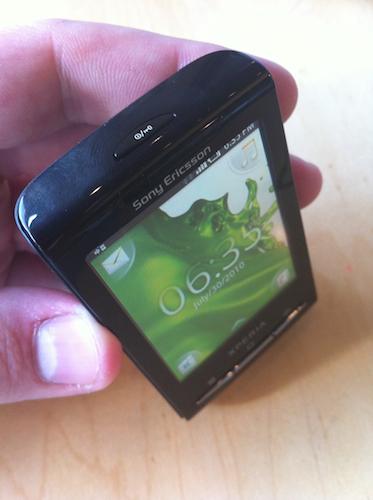
The X10 mini is…well, mini. Small. Zoolander tiny. It's so small that I found myself listening in the earpiece and moving it down to my mouth when I was ready to speak. In a world of 4 and 5-inch devices, the Sony Ericsson X10 mini comes in at a scant 3.26 inches tall by 1.97 inches wide by 0.64 inch thick. It weighs 3.11 ounces, and on one occasion, I accidentally confused it with my car's key fob.
The X10 mini looks like a baby version of the XPERIA X10. The right side houses a volume rocker and camera shortcut button, and the bottom contains the microUSB charging port and 3.5mm headphone jack. The power button is on the top, and the camera is on the back. Unlike most devices on the market today, you get a ton of goodies in the box - the phone, 2 GB microSD card, five (yes, five) extra rear covers (red, green, white, grey, and pink), AC adapter, USB cable, and a stereo headset. The device sports a 2.55-inch display, and though it's incredibly small, Sony Ericsson has tweaked the user interface enough to make it usable.
The X10 mini runs a custom build of Android 1.6 (that is optimized for Android, but in a departure from the XPERIA X10, it's quite speedy. I started testing it with the expectation of lag, but was pleasantly surprised to find that there's no slowdown whatsoever. The X10 mini's screen size allows for one widget per homescreen, but I was able to add 20 homescreens without issue. The X10 mini offers a customized T9-style keyboard that works well given the size of the phone. It's not for those that type regularly, but it's decent enough for the occasional message.
With a 5.0-megapixel camera, the X10 mini takes decent pictures. It's no match to the iPhone 4, EVO 4G, and DROID Incredible, but picture quality is decent thanks to a flash. Video recording was decent, and you're given the choice of recording for an extended time or recording for MMS.
The X10 mini ships unlocked with support for GSM 850, 900, 1800, and 1900 MHz, and 3G in the 850, 1900, 2100 MHz bands. I've been using my AT&T SIM card, and have been pleased with call quality. My callers could hear me well, and though I had some trouble balancing the X10 mini on my shoulder, audio quality was good on my end as well. When driving through a typical AT&T dead spot in North Charlotte, I was able to maintain the call, despite some choppiness for half of a mile. The speakerphone was impressive, and Bluetooth functionality worked as you would expect it to.
The X10 mini's battery is non-removable, and given the size of the device, it's on the small side. Estimated talk time is 3.5 hours, and estimated standby time clocks in at 15 days. In my early testing, battery life seems to be in line with its other Android competitors - in two separate battery tests, I have been able to get about 10 hours out of it with moderate usage.
Much more to come in the full review!